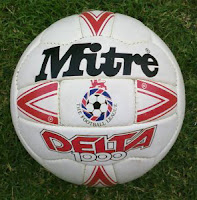Before I start, a slight disclaimer. This isn't a catalogue in the way we normally think of such things these days. It's actually a folded poster, but given the fact that it lists all the Subbuteo teams and accessories available to buy throughout the 1973-74 season, one shouldn't be too critical - not least at this early stage.
And not least too because this is a lovely piece of football memorabilia that evokes that charming crudeness that comes with all things created decades ago. The cover, for instance, shows us four young Subbuteo players from Great Britain, France, Italy and Germany extolling the virtues of this truly international table soccer game. Throw in a few tried and trusted stereotypical phrases from the continent ("Wunderbar!") and you're off to a flyer.
Elsewhere on the unfolded front of this big 50 x 70cm poster, there were neat pictures of 'some exciting accessories by Subbuteo', if indeed fence surround panels could be deemed exciting. Still, to the young boy or girl entering this plastic fantasy world, what could be more thrilling than the thought of buying some splendid floodlights or indeed a pair of new 'World Cup-type Goals'?
If that wasn't enough to satiate your Subbuteo appetite, you could also pass a spare half-hour pondering on which boxed set you'd like for your next birthday or Christmas, perhaps. There were several sets to choose from, the best of which was the all-new 'Munich World Series Edition'. Cunningly tied in with the upcoming World Cup in West Germany, this was the set that had it all including scoreboard, floodlights, TV Tower, ball boys, England team and "literature." Presumably the complete works of Shakespeare were not included in this respect.
Even if you'd picked up this football-dominated poster by mistake in your local toy shop, you were still potentially catered for. Subbuteo's now famous dalliance with rugby and cricket could also be found in miniature form along with Snooker Express, a game rarely heard of these days. In it, you had to flick a snooker player (think typical Subbuteo football player but dressed formally, chalking a cue) onto a small plastic cue ball in the hope that it would in turn pot one of the other coloured balls into a pocket. The whole thing was played within the confines of the box lid and was, by all accounts, fiendishly difficult to play. Full marks to Subbuteo for at least trying out the idea, though.
All this, however, was merely a sideshow for the main event. Without question, the vast majority of people buying this poster - sorry, catalogue - were doing so because they wanted to gawp longingly at the 165 kits displayed on the 'International Team Colours Chart'. Here there was the annual opportunity to wonder at the colours and designs rarely or never seen before.
Which team wears sky blue shirts with royal blue hoops? Who plays in red shirts with a white diagonal sash? Who on earth plays in all black with yellow trim? Such were the inconsequential ponderings generated by this arrangement of player figures stuck into a white board and photographed for our pleasure.
When it came to answering the aforementioned questions, we did, of course, need a list and one was provided across almost the entire reverse side of the poster. Though Subbuteo in more recent years gave us the basic details of team name and number sorted alphabetically or numerically, here we had a grid containing sub-divided columns for Shirt and Short Colours (but not socks), 'English League First, Second, Third and Fourth Divisions, Scottish, Irish and Welsh Teams' plus 'International and World Cup Teams'. All delightfully over-complicated, despite the top border of the poster claiming this to be a "simple chart."
As is always the way, what you see by scanning across the vast lists of teams is a snapshot of world football as it was almost 40 years ago. There are Football League teams that no longer exist (Southport, Workington), teams that no longer occupy today's global spotlight (Rot-Weiss Essen (Germany), Red Star (France)) and teams that are frankly just misspelled or misunderstood (Atletico Bilbao, Fiorentino, etc.)
There's also a healthy supply of club teams from apartheid-era South Africa such as Cape Town City, Durban United and Southern Suburbs. Though Subbuteo would ultimately branch out into the world of NASL within a few years, this was the only way for players of all kinds to get a sense of club football beyond continental Europe back in 1973-74.
As if all that wasn't enough, you could always go for something completely left field where your team choices were concerned. You could pick up a Southern League team or two if the likes of Bishop Auckland and Burton Albion were your thing, or what about FC Subbuteo (Barcelona) or even United Kingdom?
There really was something for everybody back then, and amazingly this wasn't even the peak of Subbuteo's popularity. Happy days.
And not least too because this is a lovely piece of football memorabilia that evokes that charming crudeness that comes with all things created decades ago. The cover, for instance, shows us four young Subbuteo players from Great Britain, France, Italy and Germany extolling the virtues of this truly international table soccer game. Throw in a few tried and trusted stereotypical phrases from the continent ("Wunderbar!") and you're off to a flyer.
Elsewhere on the unfolded front of this big 50 x 70cm poster, there were neat pictures of 'some exciting accessories by Subbuteo', if indeed fence surround panels could be deemed exciting. Still, to the young boy or girl entering this plastic fantasy world, what could be more thrilling than the thought of buying some splendid floodlights or indeed a pair of new 'World Cup-type Goals'?
If that wasn't enough to satiate your Subbuteo appetite, you could also pass a spare half-hour pondering on which boxed set you'd like for your next birthday or Christmas, perhaps. There were several sets to choose from, the best of which was the all-new 'Munich World Series Edition'. Cunningly tied in with the upcoming World Cup in West Germany, this was the set that had it all including scoreboard, floodlights, TV Tower, ball boys, England team and "literature." Presumably the complete works of Shakespeare were not included in this respect.
Even if you'd picked up this football-dominated poster by mistake in your local toy shop, you were still potentially catered for. Subbuteo's now famous dalliance with rugby and cricket could also be found in miniature form along with Snooker Express, a game rarely heard of these days. In it, you had to flick a snooker player (think typical Subbuteo football player but dressed formally, chalking a cue) onto a small plastic cue ball in the hope that it would in turn pot one of the other coloured balls into a pocket. The whole thing was played within the confines of the box lid and was, by all accounts, fiendishly difficult to play. Full marks to Subbuteo for at least trying out the idea, though.
All this, however, was merely a sideshow for the main event. Without question, the vast majority of people buying this poster - sorry, catalogue - were doing so because they wanted to gawp longingly at the 165 kits displayed on the 'International Team Colours Chart'. Here there was the annual opportunity to wonder at the colours and designs rarely or never seen before.
Which team wears sky blue shirts with royal blue hoops? Who plays in red shirts with a white diagonal sash? Who on earth plays in all black with yellow trim? Such were the inconsequential ponderings generated by this arrangement of player figures stuck into a white board and photographed for our pleasure.
When it came to answering the aforementioned questions, we did, of course, need a list and one was provided across almost the entire reverse side of the poster. Though Subbuteo in more recent years gave us the basic details of team name and number sorted alphabetically or numerically, here we had a grid containing sub-divided columns for Shirt and Short Colours (but not socks), 'English League First, Second, Third and Fourth Divisions, Scottish, Irish and Welsh Teams' plus 'International and World Cup Teams'. All delightfully over-complicated, despite the top border of the poster claiming this to be a "simple chart."
As is always the way, what you see by scanning across the vast lists of teams is a snapshot of world football as it was almost 40 years ago. There are Football League teams that no longer exist (Southport, Workington), teams that no longer occupy today's global spotlight (Rot-Weiss Essen (Germany), Red Star (France)) and teams that are frankly just misspelled or misunderstood (Atletico Bilbao, Fiorentino, etc.)
There's also a healthy supply of club teams from apartheid-era South Africa such as Cape Town City, Durban United and Southern Suburbs. Though Subbuteo would ultimately branch out into the world of NASL within a few years, this was the only way for players of all kinds to get a sense of club football beyond continental Europe back in 1973-74.
As if all that wasn't enough, you could always go for something completely left field where your team choices were concerned. You could pick up a Southern League team or two if the likes of Bishop Auckland and Burton Albion were your thing, or what about FC Subbuteo (Barcelona) or even United Kingdom?
There really was something for everybody back then, and amazingly this wasn't even the peak of Subbuteo's popularity. Happy days.




















































